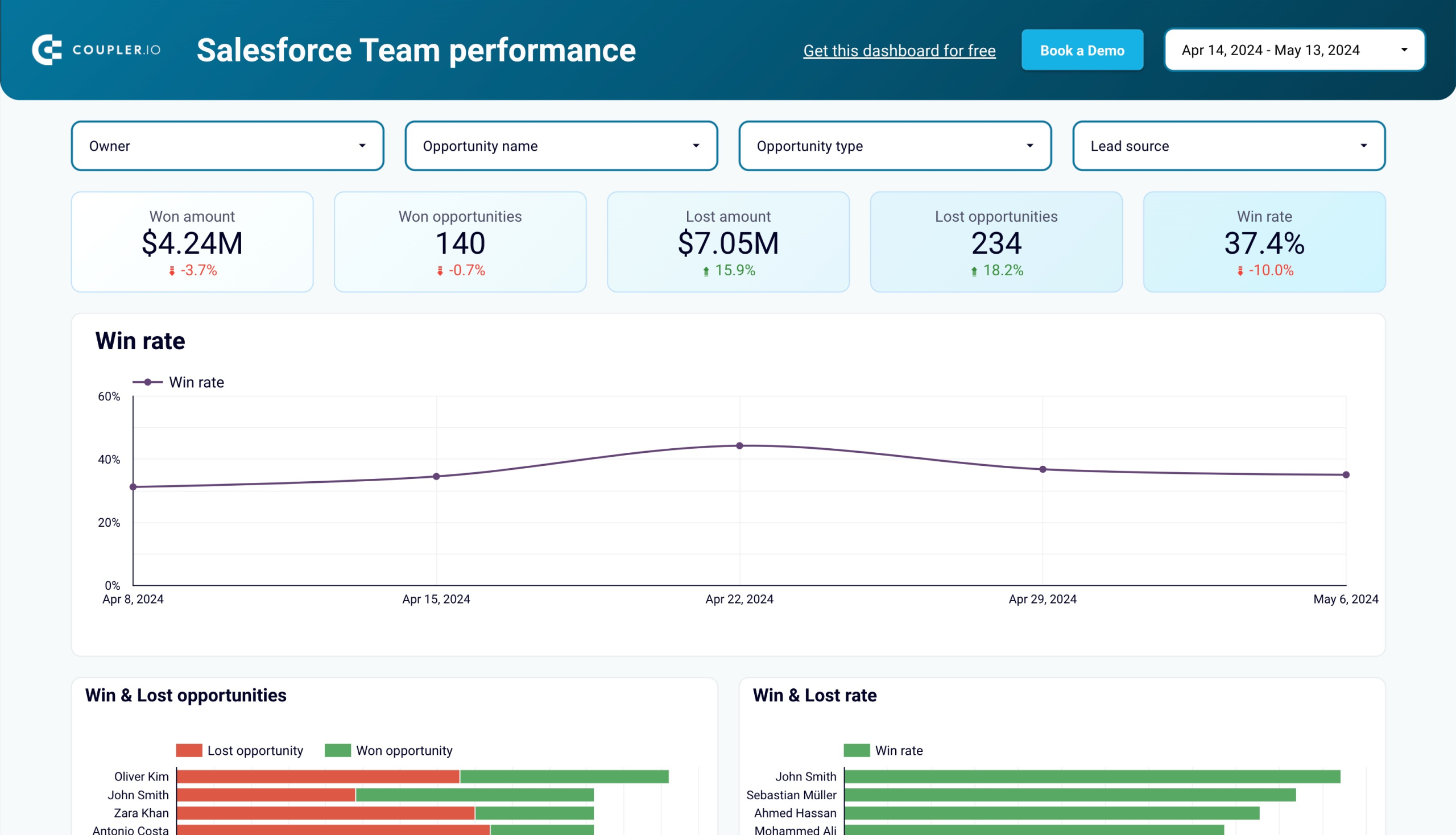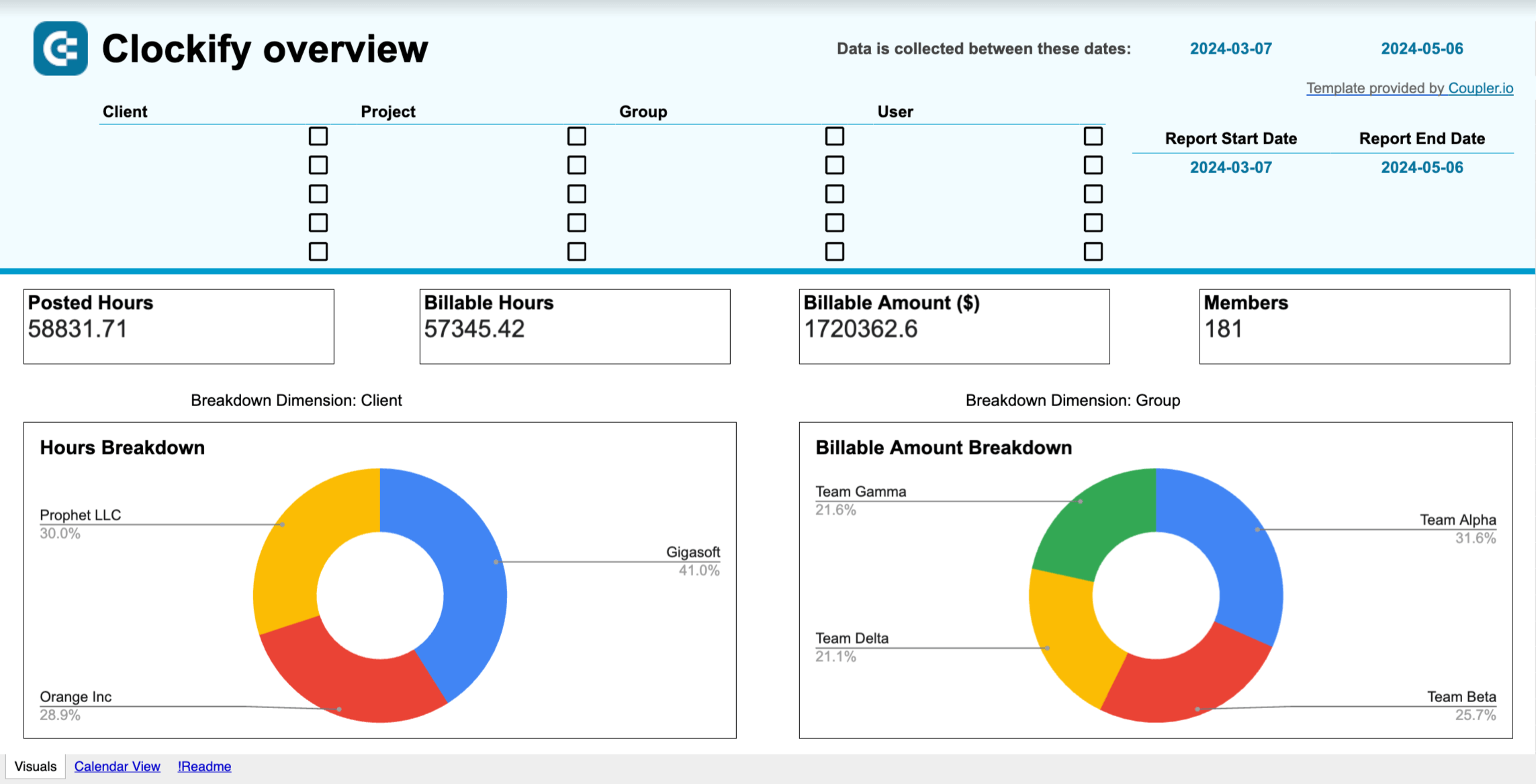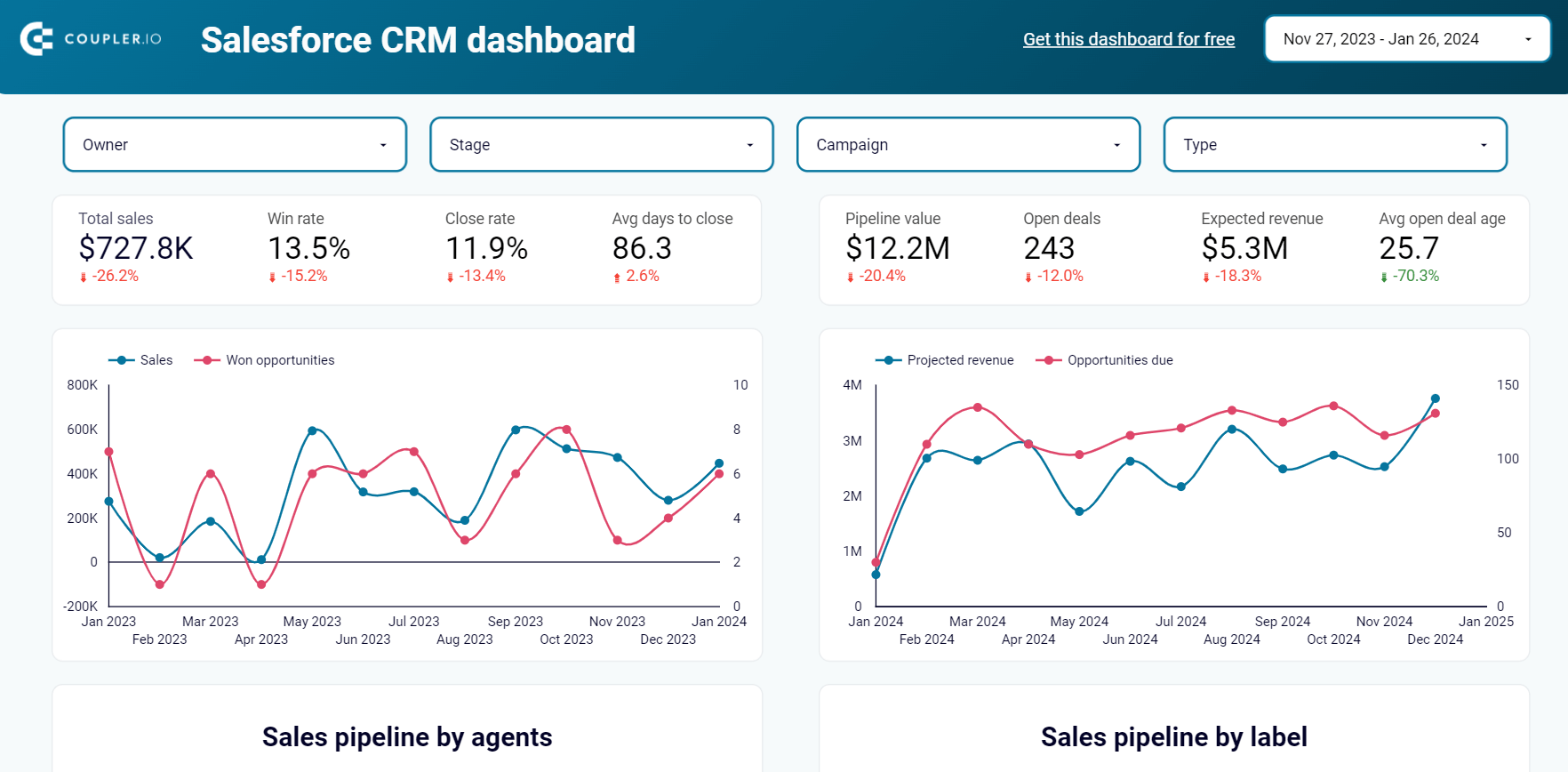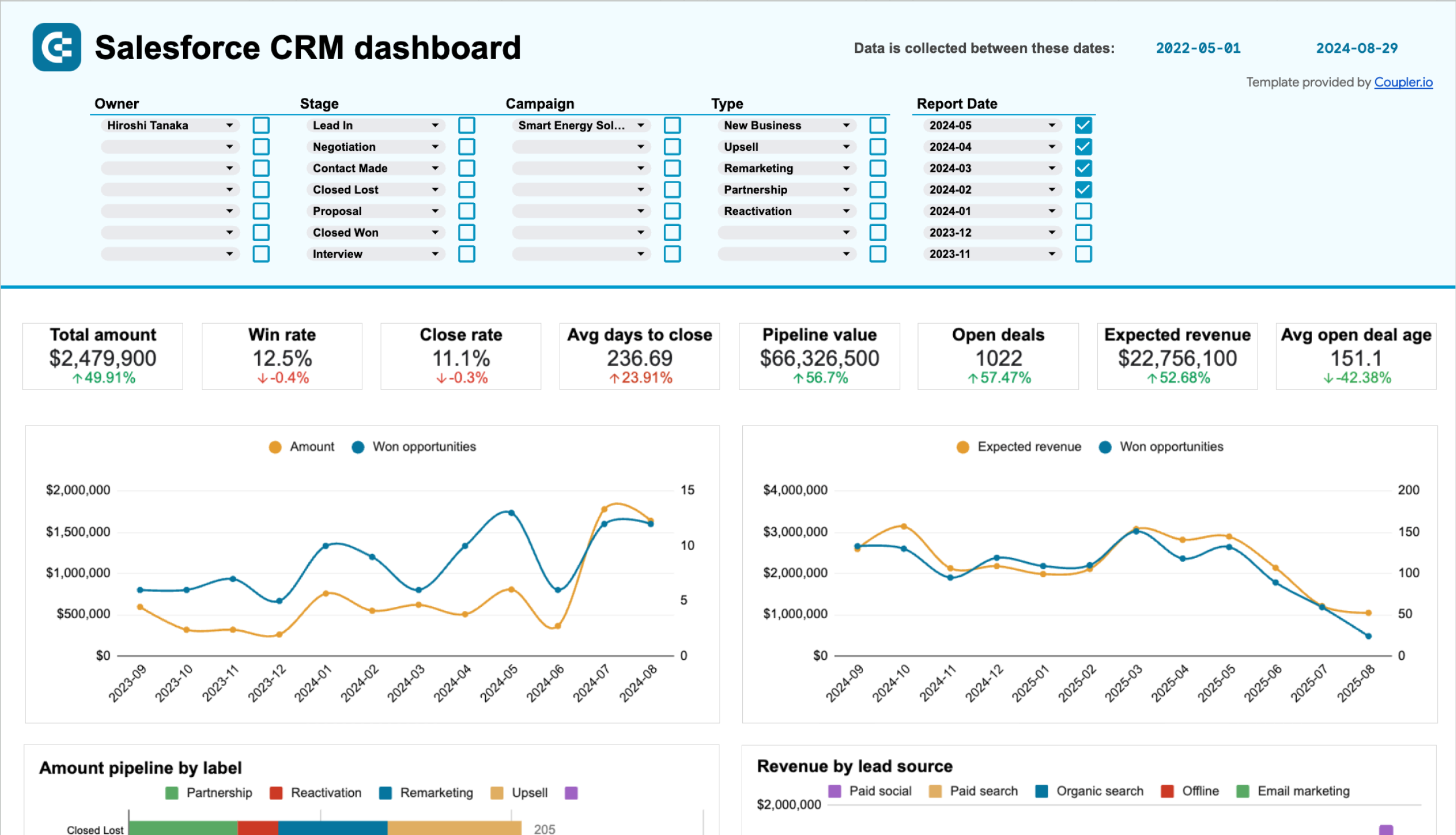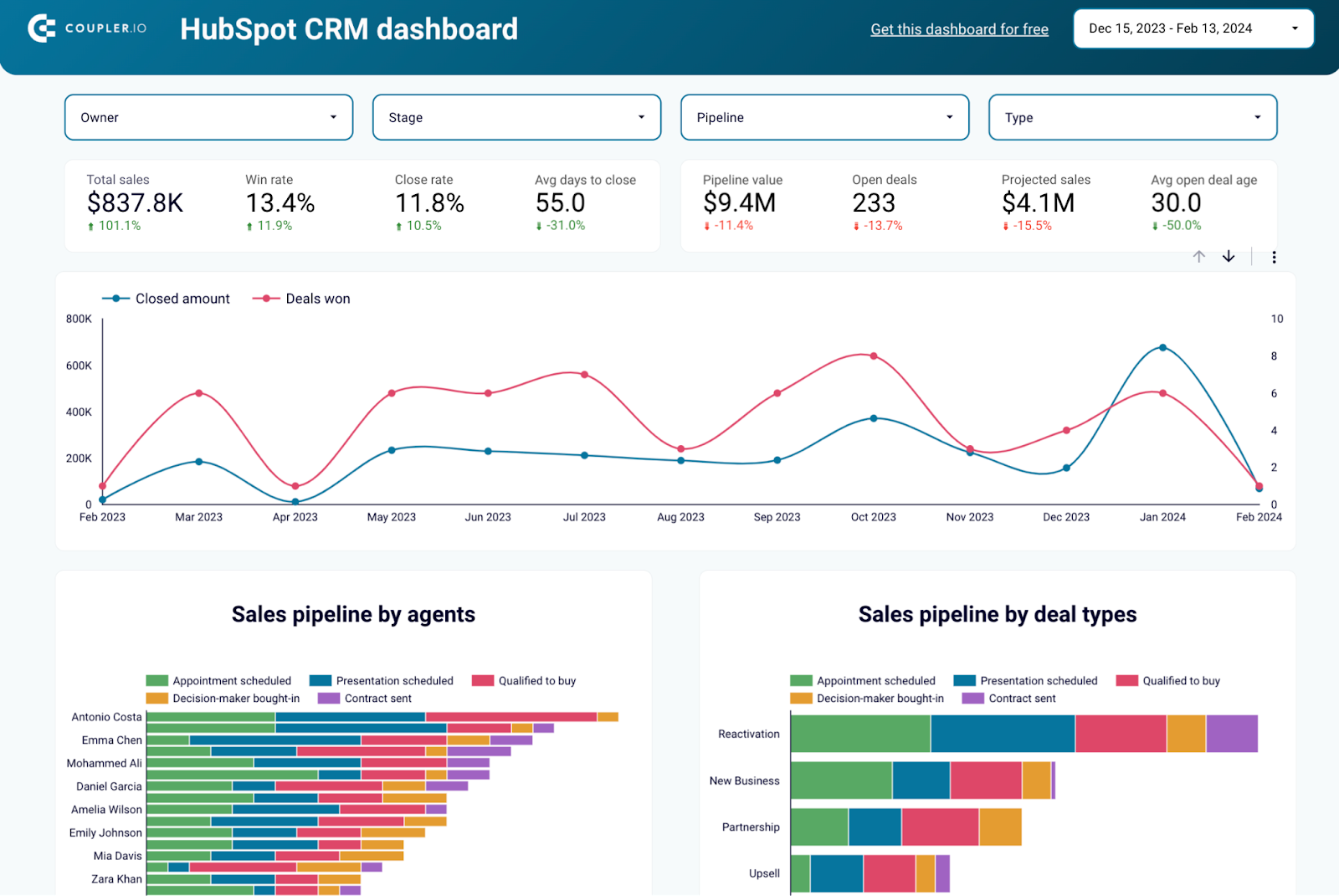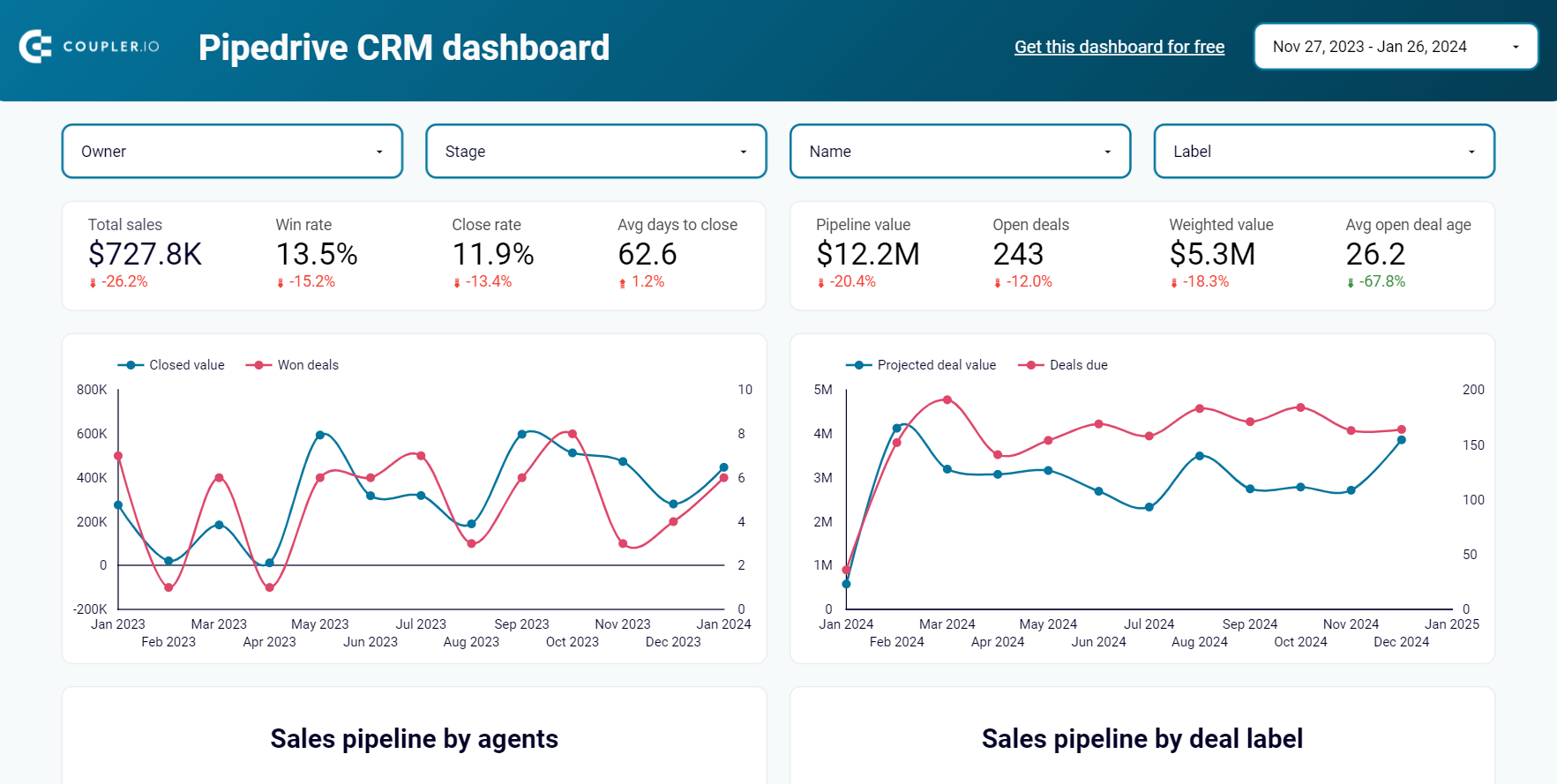Guide on How to Track Employee Performance: Methods, Tools, & Best Practices
Key challenges in performance tracking
Tracking employee performance sounds simple—until you try doing it. According to a Gartner research study, most companies invest in performance tracking systems but only 5% HR leaders are happy with their current methods.
Why?
Performance tracking isn’t just about numbers, it’s about people, behaviors, and work dynamics that don’t always fit neatly into spreadsheets.
Let’s talk about the real, everyday challenges you’re probably facing:
- Performance feels subjective, not data-driven: Managers often rely on gut feeling or personal bias when evaluating employees. A top performer might go unnoticed because they’re not vocal about their work, while someone who seems active in meetings gets rated higher even if their output is mediocre. Without objective data, reviews can feel unfair and inconsistent.
An employee working late hours might be seen as “hardworking,” but does that actually mean they are productive?
- Employees resist being tracked: No one likes the feeling of being “watched.” If performance tracking feels like surveillance, employees may resist it, worrying about micromanagement, lack of trust, or job security risks.
Time-tracking software can lead to anxiety if employees feel judged for taking short breaks, even when they are still delivering results.
- Remote and hybrid work make tracking harder: In an office, managers can see who’s engaged. But with remote teams, how do you know if someone is actually working or just moving their mouse? Tracking productivity remotely without breaching privacy or creating unnecessary stress is a major struggle.
Some remote employees might work fewer hours but deliver outstanding results, while others appear “online” all day but achieve little.
- Tracking too many metrics (or the wrong ones): It’s easy to measure hours logged, emails sent, or tasks completed. But are those enough to evaluate employees’ performance? Many businesses focus on surface-level metrics that miss true contributions and ignore qualitative aspects like problem-solving or leadership.
A customer support agent who resolves complex issues in one call may look “less productive” than an agent who handles many easy calls.
- Lack of industry benchmarks: How do you define “good” performance? Is a marketing team member producing 10 blog posts a month performing well—or should they be aiming for 15? It is difficult to track when you do not have clear benchmarks to compare against.
Without external data, performance reviews can feel arbitrary. One manager’s “great” may be another’s “needs improvement.”
- Performance tracking can feel like extra work: If the system requires endless reports, manual inputs, and follow-ups, tracking quickly becomes a burden rather than a benefit.
A project manager spends 5+ hours weekly logging performance data instead of focusing on actual project execution.
- Ensuring data accuracy: Collecting performance data is one thing, but ensuring it’s accurate, unbiased, and compliant with privacy laws is another. If tracking tools capture sensitive information without clear consent, companies risk legal issues and employee distrust.
Tools that monitor keystrokes or record employee screens can violate privacy laws, creating serious risks.
Understanding these challenges is the first step. In the next sections, we’ll discuss different tracking methods, tools, and best practices.
9 ways to track employee performance
We’ll briefly discuss the six methods by highlighting the pros and cons to help you choose the most suitable employee performance tracking approaches for your team.
1. Traditional performance reviews
Performance reviews have been around forever, yet they remain one of the most debated methods of tracking employee performance. In most companies, these annual or bi-annual reviews include self-assessments, manager evaluations, and structured discussions on an employee’s contributions, strengths, and areas for improvement.
While this method provides structure, the biggest challenge is that it only happens once or twice a year, often missing day-to-day wins and challenges. Employees may feel that feedback comes too late to be actionable, and managers struggle to remember everything accurately over a long period.
For example, if you want to “evaluate the marketing performance of an individual,” here’s what the traditional performance review looks like:
- Objective: Evaluate marketing performance
- Review Period: Annual performance review (12 months)
- Evaluation Criteria: Campaign effectiveness, content quality, collaboration, and initiative
- Assessment process:
- Employee self-assessment – Rates their own performance, and highlights achievements and challenges.
- Manager evaluation – Rates the employee based on project outcomes, teamwork, and company goals.
- Final review meeting – Discussion between employee and manager, leading to a development plan.
It takes approximately 4-6 weeks to set up and complete the traditional review process.
- Week 1-2: Define review criteria and performance metrics.
- Week 3: Collect employee self-assessments and manager evaluations.
- Week 4-5: Conduct one-on-one review meetings.
- Week 6: Finalize performance ratings, salary adjustments, and development plans.
Pros and cons of traditional performance reviews
| Pros | Cons |
|---|---|
| Structured & standardized, making it easier for large organizations to assess performance. | Too infrequent—once or twice a year means small wins or improvements go unnoticed. |
| Can be linked to salary raises & promotions, motivating employees. | Relies heavily on the manager’s perception, making it prone to bias. |
| Encourages long-term goal-setting & strategic thinking. | Employees fear negative feedback since they get limited opportunities to improve before the next review. |
| Works well for roles where outcomes are measurable over time (e.g., sales, marketing). | If not paired with regular feedback, employees may feel disconnected from their progress. |
Traditional performance reviews work best when combined with regular check-ins. Companies that use them alongside ongoing feedback and measurable KPIs/OKRs get the most value.
2. OKRs (Objectives and key results)
Performance tracking often fails because employees don’t know exactly what’s expected of them. OKRs solve this by setting clear and measurable goals that align with company priorities.
Here’s how it works:
- Objective: A big-picture goal (qualitative) that defines what you want to achieve.
- Key Results: Specific, measurable outcomes that indicate progress toward that objective.
For example, instead of saying “Improve customer service,” an OKR might look like this:
- Objective: Increase customer satisfaction.
- Key result 1: Raise CSAT scores from 80% to 90% in 3 months.
- Key result 2: Reduce average response time from 24 hours to 2 hours.
- Key result 3: Achieve a customer retention rate of 95% over the next six months.
Unlike traditional reviews, OKRs focus on continuous progress rather than just a year-end evaluation. Employees track their own performance against specific targets, making the process more data-driven and objective.
Setting up OKRs takes around 6-8 weeks, typically in these stages:
- Week 1-2: Train managers and employees on how OKRs work.
- Week 3-4: Set individual and team OKRs based on company goals.
- Week 5-6: Launch a pilot program in select teams for feedback.
- Week 7-8: Fully implement OKRs and integrate them into weekly or monthly check-ins.
Pros and cons of OKRs
| Pros | Cons |
|---|---|
| Aligns individual efforts with company-wide goals, improving focus. | If not implemented correctly, OKRs can feel like extra work instead of a performance tool. |
| Encourages continuous progress tracking rather than just annual reviews. | Employees may become too focused on numbers, ignoring qualitative performance aspects like collaboration or creativity. |
| Objective & measurable. Removes the guesswork from performance evaluation. | Setting good OKRs takes time. Poorly defined key results can lead to confusion. |
| Works well for teams with quantifiable targets (sales, marketing, engineering, etc.). | If not reviewed regularly, OKRs lose effectiveness and become just another checklist. |
OKRs bridge the gap between strategy and execution. When combined with regular check-ins and flexible goal-setting, they create a transparent way to track performance.
3. KPIs (Key performance indicators)
Tracking performance is only useful if you measure the right things. That’s where KPIs come in. They turn business objectives into measurable values so you can track progress effectively.
Unlike OKRs, which focus on achieving specific goals, KPIs help businesses monitor ongoing performance trends and ensure that employees are contributing to broader company success.
For example, to “Measure sales team performance,” a KPI-based evaluation might look like this:
- Goal: Assess the effectiveness of the sales team.
- KPIs to track: Monthly revenue generated, lead conversion rate, average deal size
- Assessment process:
- Real-time tracking – Sales reps’ performance is monitored weekly based on their numbers.
- Quarterly reviews – Team leads evaluate trends, adjusting sales strategies where necessary.
- Annual KPI benchmarking – Compare team performance to industry standards and adjust targets for the next year.
Rolling out KPIs typically takes 3-6 weeks, depending on the complexity of the metrics being tracked:
- Week 1-2: Identify key performance indicators relevant to each role.
- Week 3-4: Implement tracking tools (CRM, dashboards, etc.).
- Week 5-6: Align KPIs with individual/team goals and integrate them into review cycles.
Pros and cons of KPIs
| Pros | Cons |
|---|---|
| Provides clear, measurable insights into performance. | Not all job roles have easily measurable KPIs (e.g., creative or strategy-based roles). |
| Helps track real-time progress rather than waiting for annual reviews. | Can lead to tunnel vision, where employees prioritize hitting numbers over meaningful work. |
| Encourages data-driven decisions instead of relying on subjective opinions. | Employees might manipulate metrics to meet targets rather than focusing on genuine results. |
| Aligns well with company-wide goals, ensuring transparency in performance tracking. | Tracking too many KPIs can create data overload and reduce clarity. |
KPIs are great for measuring ongoing performance trends, but they work best when they’re meaningful and relevant to an employee’s role. The key is to track what truly matters instead of getting lost in numbers.
4. Project-based evaluations
For roles that are highly task-oriented, such as software developers, designers, or product managers, traditional performance-tracking methods often fail. Instead of looking at overall output or hours worked, project-based evaluations measure an employee’s contribution to specific projects.
Unlike OKRs or KPIs, which focus on long-term goals, this method provides a real-time view of performance based on an employee’s direct impact on projects.
For example, to “Assess a software developer’s performance,” a project-based evaluation might look like this:
- Goal: Evaluate software developer performance on a new product feature.
- Evaluation criteria: Code quality (Number of bugs reported, adherence to coding standards), task completion (Number of assigned features completed on time), and collaboration (Interaction with product managers, designers, and QA teams).
- Assessment process:
- Task breakdown – Project milestones are set at the start, with clear deliverables.
- Performance tracking – Progress is evaluated weekly based on task completion and feedback from teammates.
- Final review – At project completion, a retrospective evaluates individual contributions, efficiency, and areas for improvement.
Project-based evaluations take 4-8 weeks, depending on project length and team structure:
- Week 1-2: Define project-based performance metrics for each role.
- Week 3-4: Set up tracking tools (JIRA, Trello, Asana, etc.).
- Week 5-8: Conduct evaluations at project milestones and at completion.
Pros and cons of project-based evaluations
| Pros | Cons |
|---|---|
| Provides real-time, task-specific performance insights. | May undervalue employees working on long-term initiatives that don’t show quick results. |
| Helps identify strengths & weaknesses in a project-specific context. | Doesn’t capture broader contributions, like mentoring or strategy. |
| Works well for technical and creative roles with tangible deliverables. | Can be disruptive if overused—employees may feel pressured to perform on every project. |
| Encourages team collaboration & accountability. | Success is often team-dependent, making individual evaluation challenging. |
Project-based evaluations are ideal for technical, creative, and task-driven roles. But, to fully assess employee performance, they should be combined with other methods like KPIs for ongoing measurement or OKRs for long-term impact.
5. Time tracking
With the rise of remote work, time tracking has become essential for monitoring employee performance. By tracking how long employees spend on tasks, you can understand work patterns, optimize efficiency, and identify bottlenecks. In industries like consulting, software development, and remote work, time tracking makes sure that employees are spending their time on the right tasks and that work is evenly distributed.
You can use free online time clock, time-tracking tools, and software to see how employees spend their work hours. Employees can start a timer for a project or manually record their hours later. This data shows whether employees are overworking or underworking.
For example, “Tracking a designer’s time,” looks like this:
- Goal: Analyze a designer’s productivity and workload.
- Time-tracking metrics: Hours logged per project, time spent on revisions, Idle vs. active time
- Assessment process:
- Time logging – Employees track time spent on different tasks using tools like Clockify or Harvest.
- Pattern analysis – Managers analyze work habits and identify areas for process improvement.
- Optimization – Adjust workloads, deadlines, or processes based on tracked time insights.
Setting up a time-tracking system for your team should take around 2-4 weeks, depending on employee adoption:
- Week 1: Introduce the tool, and explain why tracking is beneficial.
- Week 2-3: Train employees on best practices, and encourage usage.
- Week 4: Review the first data set, and refine the tracking approach.
Pros and cons of time tracking
| Pros | Cons |
|---|---|
| Helps identify productivity trends and inefficiencies. | Can feel like micromanagement if not implemented well. |
| Useful for billing clients and project cost estimation. | Doesn’t capture quality of work, just time spent. |
| Encourages better time management and workload balance. | Employees may manipulate time logs to appear productive. |
| Beneficial for remote teams & freelancers who work asynchronously. | Can cause stress and resentment if overused. |
Time tracking works best when used as a tool for optimization rather than surveillance. When combined with KPIs and project-based evaluations, it provides valuable insights without making employees feel micromanaged.
6. 360-degree feedback
As the name suggests, this is an overall feedback to evaluate employee performance where an employee receives feedback from everyone they have worked with during the quarter, half-year, or year. This includes managers, peers, subordinates, and sometimes even clients. It also involves self-assessment, providing a well-rounded view of performance.
This method helps eliminate bias, providing a holistic view of an employee’s strengths and areas for improvement. It works best in collaborative environments where employees interact with multiple teams and stakeholders.
For example, to “Evaluate a project manager’s leadership skills,” a 360-degree feedback evaluation includes the following:
- Goal: Assess a project manager’s leadership and collaboration skills.
- Evaluation criteria: Team communication (rated by direct reports on clarity and responsiveness), problem-solving ability (rated by peers based on conflict resolution and decision-making, and leadership & vision (Rated by senior management on strategic contributions).
- Assessment process:
- Feedback collection – Surveys sent to colleagues, subordinates, and managers.
- Anonymous review – Responses compiled into a consolidated report.
- Coaching & development plan – Employees discuss findings with their manager and set improvement goals.
To create a 360-degree feedback system takes 5-7 weeks depending on company size:
- Week 1-2: Define evaluation criteria and design feedback forms.
- Week 3-4: Train employees and encourage honest, constructive feedback.
- Week 5-6: Collect responses and analyze data.
- Week 7: Share results and set action plans.
Pros and cons of 360-degree feedback
| Pros | Cons |
|---|---|
| Provides a well-rounded view of employee performance. | Time-consuming—requires coordination across multiple teams. |
| Encourages a feedback culture, promoting continuous growth. | Can be subjective—personal biases may affect feedback. |
| Highlights hidden strengths & weaknesses that a manager might miss. | Employees may hesitate to provide honest feedback, fearing repercussions. |
| Works best for leadership, cross-functional teams, and customer-facing roles. | Requires a structured system to ensure feedback is constructive and actionable. |
360-degree feedback is powerful when done right. But it should be used as a development tool, not a ranking system. Pairing it with KPIs or OKRs helps create a balanced performance evaluation approach.
7. AI-powered tracking methods
Many businesses struggle with performance tracking because they do not find the time to conduct frequent assessments. Even if they do, it can be slow, biased, and lack real-time data. With AI, you can identify patterns in productivity and engagement while ensuring performance reviews are data-driven rather than opinion-based.
AI-powered tracking works by analyzing multiple data points to assess an employee’s contributions and engagement. Some common ways AI is used in performance tracking include:
- Real-time productivity analysis – AI tracks task completion rates, work efficiency, and response times to identify top performers and those needing support.
- Continuous feedback and nudges – Instead of waiting for annual reviews, AI provides real-time feedback based on an employee’s work patterns. Some tools use AI-generated “nudges” to encourage better work habits or suggest learning materials for skill improvement.
- Predictive analytics for performance forecasting – AI analyzes historical data to predict future performance trends. It helps managers to identify employees at risk of burnout or those ready for promotion.
- Automated performance reviews – AI-generated reports summarize an employee’s strengths, weaknesses, and areas for growth based on real-time performance data. Instead of managers spending hours compiling feedback, AI can generate reports in minutes.
Setting up AI-powered performance tracking requires careful planning to ensure employees trust the system and data privacy. The initial setup process might take 6-10 weeks.
- Week 1-2: Identify tracking goals and select the right AI tool.
- Week 3-4: Integrate AI with existing HR and project management systems.
- Week 5-6: Train managers and employees on how AI-powered tracking works.
- Week 7-8: Launch a pilot program and gather feedback on its effectiveness.
- Week 9-10: Full implementation with ongoing performance monitoring and adjustments.
For example, a software company using AI-powered performance tracking can identify issues like overloaded developers, inefficiencies in QA, and other hidden slowdowns. Now, managers redistribute tasks, optimize workflows, and take action on time.
Pros and cons of AI-powered tracking methods
| Pros | Cons |
|---|---|
| Provides real-time performance insights, reducing reliance on outdated reviews. | Privacy concerns—employees may feel uncomfortable with AI tracking their work. |
| Uses data-driven assessments, reducing manager bias. | Requires accurate data—flawed inputs can lead to misleading insights. |
| Helps predict future performance trends, aiding in promotions and training. | AI struggles with measuring soft skills like creativity and leadership. |
| Encourages continuous feedback rather than yearly performance reviews. |
While AI can automate data collection, track work patterns, and save time, it cannot take over completely. If companies hand over everything to AI, performance tracking will fall short. AI may show trends, highlight workload issues, or suggest adjustments, but it cannot assess creativity, leadership, or problem-solving skills.
Bonus: How work setup affects tracking methods
Remote vs in-office tracking differences
What works in an office may not be practical for remote teams, and forcing the same approach on both can lead to gaps in performance tracking.
For example, in an office setting, managers can directly observe work habits and track productivity through attendance, team interactions, and visible contributions. But in a remote setup, tracking needs to be more data-driven, relying on project progress, digital collaboration, and AI-powered insights.
Let’s get a quick glance at how performance tracking differs for In-office and remote workers.
| Factor | In-Office tracking | Remote tracking |
|---|---|---|
| Work visibility | Managers can observe work habits, attendance, and collaboration. | Requires tracking tools to monitor workflow, team engagement, and task completion. |
| Productivity metrics | Task completion rates, in-person supervision, and real-time feedback. | Output-based tracking, milestone tracking, and AI-driven analytics. |
| Time tracking | Used to monitor work hours and ensure accountability. | Helps prevent overwork, track billable hours, and maintain a balanced workload. |
| Collaboration & Feedback | Real-time meetings, direct feedback, and team discussions. | Digital communication tools, regular check-ins, and async reporting. |
Tracking methods should align with the work setup, not the other way around. Time tracking, OKRs, KPIs, and 360-degree feedback work well for both office and remote employees but must be adapted to fit different work styles.
Hybrid tracking approaches
As more companies adopt hybrid work models, performance tracking becomes even more complex. Remote and in-office employees work differently, and applying a single tracking method to both can lead to unfair assessments.
A hybrid approach ensures that employees are evaluated based on their actual contributions, not just their work location. The key is to combine multiple tracking methods in a way that works for both remote and in-office teams.
To create an effective hybrid tracking system, companies need to blend different tracking methods. For example,
- OKRs for everyone – Ensured all employees worked toward clear, measurable goals, whether remote or in-office.
- Project-based evaluations for remote employees – Focused on task completion, collaboration, and output rather than hours worked.
- AI-powered tracking for insights – Used AI tools to analyze productivity trends and engagement for both remote and in-office employees.
- Time tracking for remote employees – Helped prevent overwork and underwork, ensuring a healthy balance between flexibility and accountability.
The key is balance. Remote employees need structured tracking without micromanagement, and in-office employees should be evaluated based on contributions, not just presence.
By using the right mix of tracking methods, companies can create a system that is fair, transparent and focused on actual performance.
What data to track for employee performance?
After exploring different performance tracking methods, let’s look at the specific data points that help assess employee performance better. Using the right tracking tools, companies can monitor both quantitative data (e.g., hours worked, tasks completed) and qualitative data (e.g., collaboration, work quality). This data must be benchmarked against industry standards, validated for accuracy, and tracked ethically.
Time-tracking data
Tracking time provides insights into work hours, productivity patterns, and potential burnout risks.
What to track:
- Total Hours Worked: Helps monitor workload distribution, preventing overwork or underutilization.
- Time Spent on Specific Tasks: Provides insights into efficiency and task prioritization.
- Breaks & Idle Time: Helps balance productivity and burnout prevention.
- Activity Monitoring (if applicable): Some tools track computer activity to analyze focus levels, but this must be done ethically and transparently.
Industry benchmarks:
- Standard workweek hours: 40–45 hours per week (varies by country and industry).
- Overtime threshold: More than 50 hours per week may indicate workload imbalances.
- Focused work periods: Knowledge workers typically have 3–5 hours of deep work daily.
Data validation methods:
- Cross-verification: Compare logged hours with completed work to spot inconsistencies.
- Outlier detection: Identify extreme variations (e.g., sudden spikes in logged hours).
- Approval System: Require managerial approval for significant overtime or unusual time patterns.
Privacy compliance checklist:
- Transparency: Inform employees about what is being tracked and why.
- Consent: Obtain explicit approval before implementing monitoring tools.
- Data security: Ensure time-tracking records are stored securely with restricted access.
- Follow local labor laws and GDPR/CCPA compliance: Adhere to country-specific data protection regulations.
Project management data
Monitoring project progress helps ensure tasks are completed on time and workloads are balanced.
What to track:
- Task completion rate: Measures efficiency in completing assigned work.
- Number of projects handled: Tracks workload and resource allocation.
- Time taken per project: Helps optimize deadlines and prevent delays.
- Communication & collaboration metrics: Includes Slack messages, meetings attended, and emails sent (for managerial roles).
Industry benchmarks:
- Project completion rate: 80–90% of assigned projects completed on time is a strong benchmark.
- Average project duration: Software projects take 2–6 months, while marketing campaigns run for 6–12 weeks.
- Meeting time vs. focus time: Teams should aim to spend at least 50% of their work hours on actual tasks rather than meetings. Again, this varies for different roles.
Data validation methods:
- Milestone checks: Instead of waiting until project completion, track progress at key phases (e.g., planning, execution, review) to ensure timelines are met.
- Stakeholder feedback: Validate success through feedback from managers and clients.
- Historical comparison: Compare new project timelines with previous ones to spot inefficiencies.
Privacy compliance checklist:
- Data minimization: Only collect necessary project-related metrics.
- Role-based access: Restrict data visibility based on job function.
- Retention policy: Delete old project records based on compliance guidelines.
Performance review data
Evaluating feedback and goal progress gives a clear picture of employee growth and contributions.
What to track:
- Goal progression: Tracks how well employees meet their individual and team goals.
- Feedback scores: Evaluations from peers, subordinates, and managers.
- Skills & competency development: Measures learning progress over time.
Industry benchmarks:
- Average feedback rating: Many companies use a 5-point rating system, where 4.0+ is considered strong.
- Employee engagement scores: Industry standards suggest an 80%+ engagement rate signals a healthy workforce.
- Annual review frequency: Top-performing companies conduct check-ins every quarter, not just annually.
Data validation methods:
- Multi-rater feedback: Use 360-degree reviews for a balanced perspective.
- Review calibration: Hold managerial discussions to ensure fair evaluations.
- Anonymous feedback (if needed): In some cases, keeping peer feedback confidential improves honesty.
Privacy compliance checklist:
- Confidentiality: Keep employee performance reviews private.
- Data accuracy rights: Allow employees to dispute unfair ratings.
- Feedback transparency: Ensure employees understand how their performance is assessed.
Job-specific data
Tracking role-specific metrics helps measure performance based on job responsibilities. You can collect different types of real-time data from job-specific tools like HubSpot, SmartRecruiters, and GitHub.
What to track (examples by role):
- Sales teams: Deals closed, revenue generated, average deal size.
- Recruiters: Positions filled, time-to-hire, candidate satisfaction scores.
- Software developers: Number of commits, pull requests, and code reviews.
Industry benchmarks:
- Sales conversion rates: 2–5% for outbound sales, 10–20% for inbound. This will vary based on factors such as industry, target audience, company size, and more.
- Recruitment speed: Time-to-hire should be under 30 days for most industries, but it varies by position. Entry-level and mid-level vacancies are easy to close, but leadership positions take time.
- Development efficiency: Average code review turnaround is 24–48 hours.
Data validation methods:
- Automated performance reports: Use dashboards for real-time insights.
- Peer reviews: Ensure work quality is validated by team members.
- Benchmark comparisons: Track performance trends over multiple quarters.
Privacy compliance checklist:
- Purpose limitation: Use job-specific data only for performance evaluation.
- Secure storage: Implement encryption and access restrictions.
- Anonymized reports: Where possible, avoid unnecessary exposure of individual performance data.
Data integration consideration: When tracking multiple performance metrics across different platforms, consolidating this data becomes crucial. Coupler.io can automatically pull data from various sources (such as time-tracking tools, project management platforms, and CRM systems) into centralized dashboards or spreadsheets. With its help, you ensure your performance tracking is based on fresh, accurate data without manual export-import processes.
What employee performance monitoring tools can you use?
Performance tracking is only as effective as the tools you use. You can choose them based on your preferred tracking methods. We’ve divided performance monitoring tools into five categories based on the different tracking approaches.
1. Time-tracking tools
These tools focus on measuring the amount of time employees spend on different tasks and projects. Time-tracking software is critical for understanding work patterns, improving time management, and ensuring accurate billing for client projects. Also, with some tools, you can monitor employees’ computer activity, which offers a more comprehensive understanding of work habits, productivity levels, task priorities, and potential areas for improvement. Some of the common time-tracking tools are:
- Clockify: Employees can track work hours across different projects using a simple timesheet. You can either log time manually or track real-time with a timer. Clockify is a simple way to analyze your company’s efficiency across projects, clients, departments, and employees.
- Harvest: This is a combination of time tracking and invoicing software. Harvest is useful for freelancers and agencies that bill clients for the number of hours worked.
- Timecamp: If you are someone who wants to dive deep into time-tracking data, then Timecamp is for you. It comes with automatic time-tracking capabilities, providing in-depth insights into productivity and project time allocation.
Coupler.io allows you to collect data from Clockify and Harvest for analysis of time-tracking performance. You can transform this data into insightful reports and load them in spreadsheets or BI tools, or even benefit from the predesigned dashboard templates.
2. Project management tools
While these tools are generally used to manage projects of any scale, you can also use them to track individual employee performance. Project management tools offer a centralized platform for managing tasks, deadlines, and resources, making it easier for managers to track employee performance based on metrics such as task completion rates, time taken to complete a task, number of tasks handled in a specific time period, etc.
Below are some of the popular project management tools:
- JIRA: Suitable for software teams with features like bug tracking, issue management, and customizable project workflows.
- Asana: Useful in streamlining task planning and collaboration. It makes project progress visible and manageable for any team.
- Trello: This comes with a visual task management experience with its intuitive, card-based Kanban boards.
- ClickUp: An all-in-one project management solution with customizable features for tasks, docs, and goals.
- Basecamp: Helpful in simplifying project management with simple features for task lists, communication, and file sharing.
Coupler.io enables you to extract performance data from project management tools like JIRA, Asana, and Trello for comprehensive analysis. You can derive deeper performance insights into team productivity trends and individual contributions by building dynamic reports without any hassle.
3. Performance review tools
These are used by almost every HR team for performance management. These tools streamline the performance evaluation process, facilitating more frequent, transparent, and fair assessments. Performance review tools support goal setting, feedback exchanges, and the tracking of individual and team progress over time.
To get started, you can check out the performance review tools below:
- BambooHR: A comprehensive HR platform with performance management features. BambooHR streamlines performance reviews, goal setting, and employee feedback in a single system.
- Lattice: This focuses on giving structured feedback that can be used for employee improvement. Lattice also specializes in goal alignment, where individual goals are aligned with company goals.
- Deel: Primarily known for global payroll and compliance, Deel also supports performance management. The HR platform helps organizations navigate the complexities of managing a global workforce.
4. Job-specific tools
This category is not based on any specific tracking method. It is based on using data as a tool to track employee performance effectively. Unlike manual updates required in project management and performance review tools, job-specific tools provide a source of real-time data. To understand how this works, let’s go through a few job-specific tools below:
- Pipedrive: A CRM tool used by sales professionals. Pipedrive tracks customer interactions and sales processes in real-time. When your goal is to close x number of deals in a month, you can see the number of deals in different statuses (not started, in progress, closed.)
- SmartRecruiters: An applicant tracking system (ATS) tracks the complete recruitment process. You can use data like the number of candidates screened, the number of interviews scheduled, and more to evaluate a recruiter’s performance.
- GitHub: This is an essential tool for engineers where they facilitate code version control and collaboration. You can track data like pull requests, code reviews, contributions to projects, and more.
5. AI & automation tools
Modern performance tracking is more than manual reviews and time logs. AI and automation tools bring real-time analytics, predictive insights, and automated reporting into the process. They help reduce bias, improve accuracy, and streamline performance evaluations without overwhelming managers with endless data.
Here are three tools that improve performance tracking using AI-driven insights and automation:
- Centrical: Uses AI-powered coaching to provide personalized feedback, track employee engagement, and gamify performance management. It helps employees stay motivated while ensuring managers have real-time insights into productivity trends.
- 15Five: An AI-driven performance management tool that collects employee check-ins, feedback, and engagement data to generate actionable insights. It enables companies to identify strengths, skill gaps, and areas for improvement without relying on periodic reviews alone.
- Coupler.io: A no-code reporting automation tool that connects 60+ sources into a single, real-time dashboard. It automatically pulls data from project management tools, time trackers, and CRM systems, ensuring that employee performance metrics are always up-to-date and accessible in one place.
How to track employee performance using dashboards?
After collecting the performance data from different tools, it is time to understand the data to assess the performance of an individual and the team. Even though most of these tools have built-in analytics features, they are fixed and limited. A dashboard will help you focus on the metrics that are important to you. They convert complex data from employee performance tools to actionable insights. The review meetings will be objective and data-driven, with concrete data to make informed decisions.
Below are a few employee performance dashboard examples for you to get started.
Sales team performance dashboard for Salesforce
If you use Salesforce for managing your sales pipeline, this sales team performance dashboard will be quite helpful. It provides a sales overview with the key metrics such as won and lost amount, and breaks down the insights by each member of your sales team. As a result, you can see both the full picture and its pieces to make data-driven decisions.
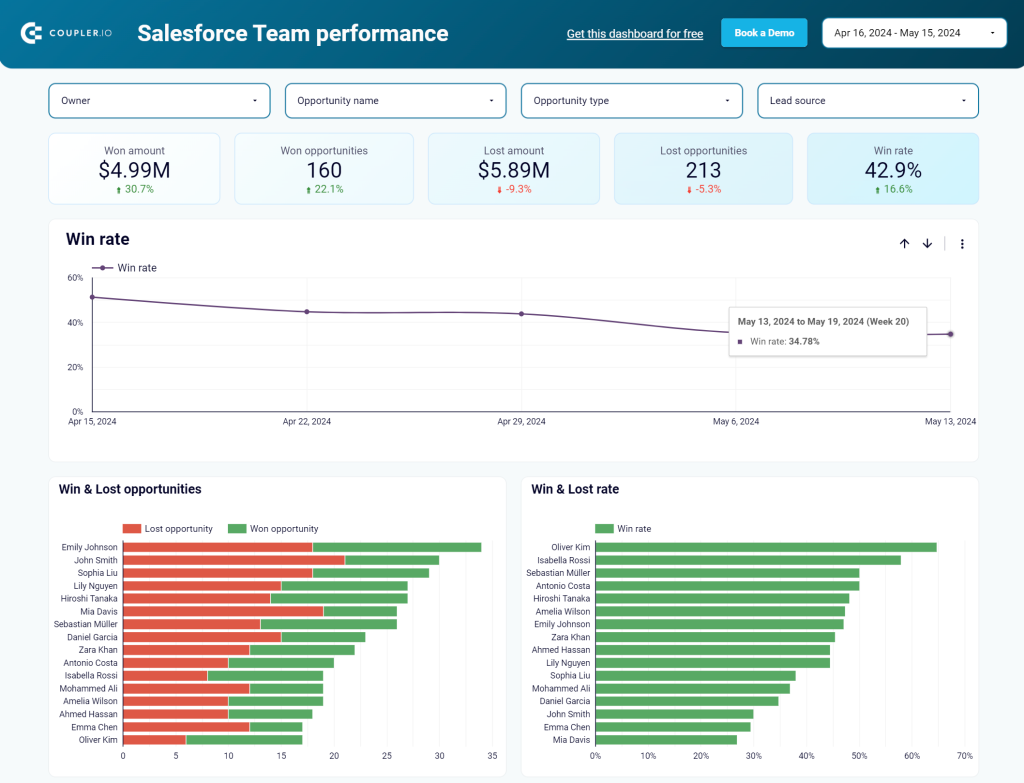
The dashboard is available as a template in Looker Studio and Google Sheets. Both options and equipped with a no-code Salesforce connector by Coupler.io. So, you only need to connect your Salesforce account to populate the dashboard with your data. In a few minutes, you can track and analyze your employee performance. Choose the template version that fits your needs and try it yourself right away for free.
Time-tracking dashboards
Before time-tracking tools, manual timesheets were the primary method for recording employees’ hours. Despite having the data, analyzing it was challenging due to data inconsistencies. However, time-tracking tools have simplified this process significantly. You can understand different time tracking metrics like hours breakdown, billable amount breakdown, hours by clients, and more from these dashboards.
Time-tracking dashboard for Clockify
Here’s an example of a time-tracking dashboard for Clockify users. Look for data trends to identify high productivity or potential inefficiencies like mismatched billable hours and earnings. Also, you can compare logged hours with active user counts to balance the team workload and prevent burnout.
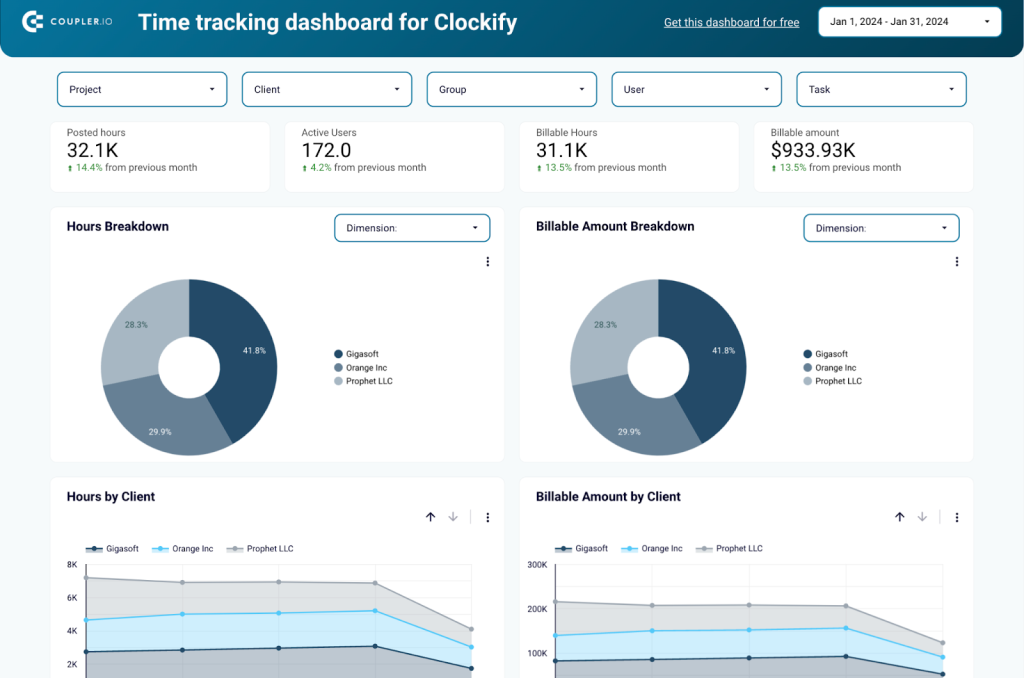
If you use Clockify as your time-tracking tool, then you can use this dashboard template in Looker Studio for your own data. Simply follow the instructions under the Readme tab, and you’ll have your Clockify dashboard set up in just a few minutes.
If you prefer building your reports in spreadsheets, then check out the Clockify time-tracking dashboard in Google Sheets. Basically, this is the same reporting solution introduced above but designed for another destination app. It also has a built-in Coupler.io connector to load data from your Clockify account.
Time-tracking dashboard for Harvest in Looker Studio
Another popular tool for time-tracking is Harvest. It is most commonly used by freelancers and agencies to manage their time and workload across different clients.
This time tracking dashboard for Harvest can give you unique insights like the number of hours spent on each client, users with the most hours, users with the least hours, and more. As an agency, knowing these metrics is crucial to identifying the top-performing employees and profit-generating clients. With such insights, you can optimize your processes, revise your billing, and improve employee productivity.
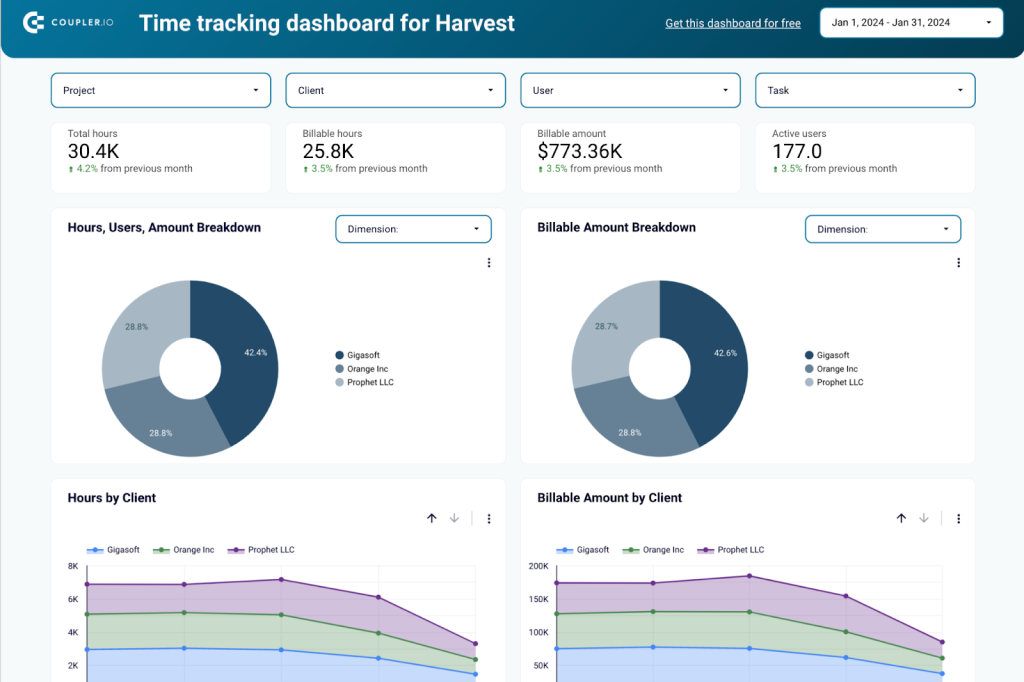
You can also filter the dashboard data by project, client, user, and task to conduct an in-depth analysis.
Google Calendar dashboard
Google Calendar is another tool used in organizations to schedule and conduct meetings. So, it collects different meeting data that can be used in tracking employee performance.
A Google Calendar Dashboard will be useful to know insights like meeting hours, meeting breakdowns, out-of-office hours, and more. Employees in leadership, sales, and customer success tend to spend a lot of time on meetings. Tracking their meeting times and understanding Google Calendar analytics can give better insights into how they use their time.
You can either create a Google Calendar dashboard or export Google Calendar to Google Sheets and BigQuery to store the data.
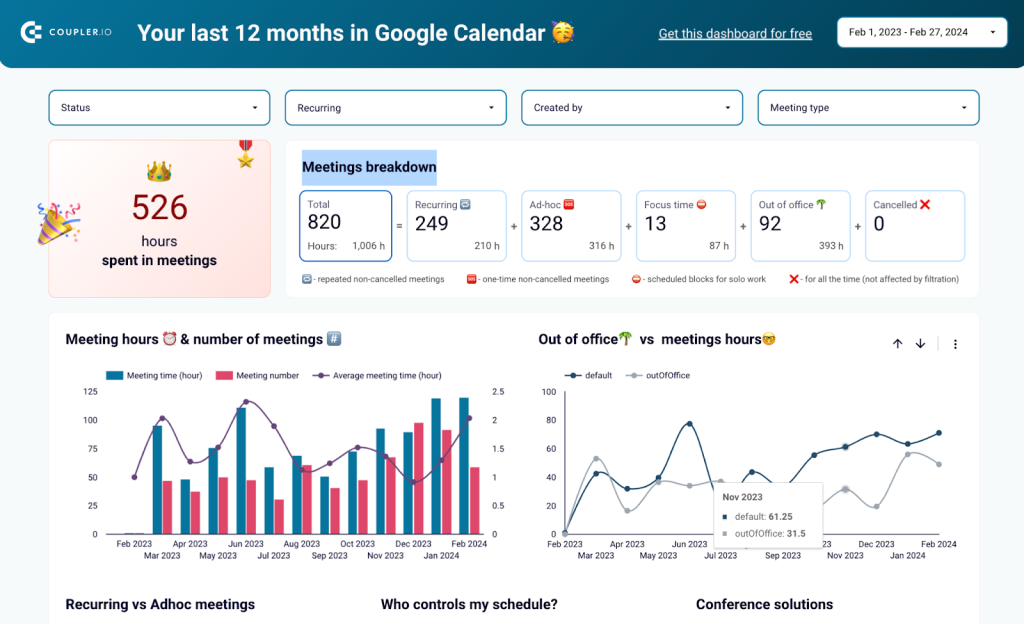
CRM dashboards
A CRM dashboard is primarily used to track the performance of the sales process. But it also has interesting metrics and insights that can help you in tracking employee performance. You can find insights about the sales pipeline by agents, agent comparison, top agents, and worst agents by amount. These metrics can be used to check if the sales agent met their sales goals.
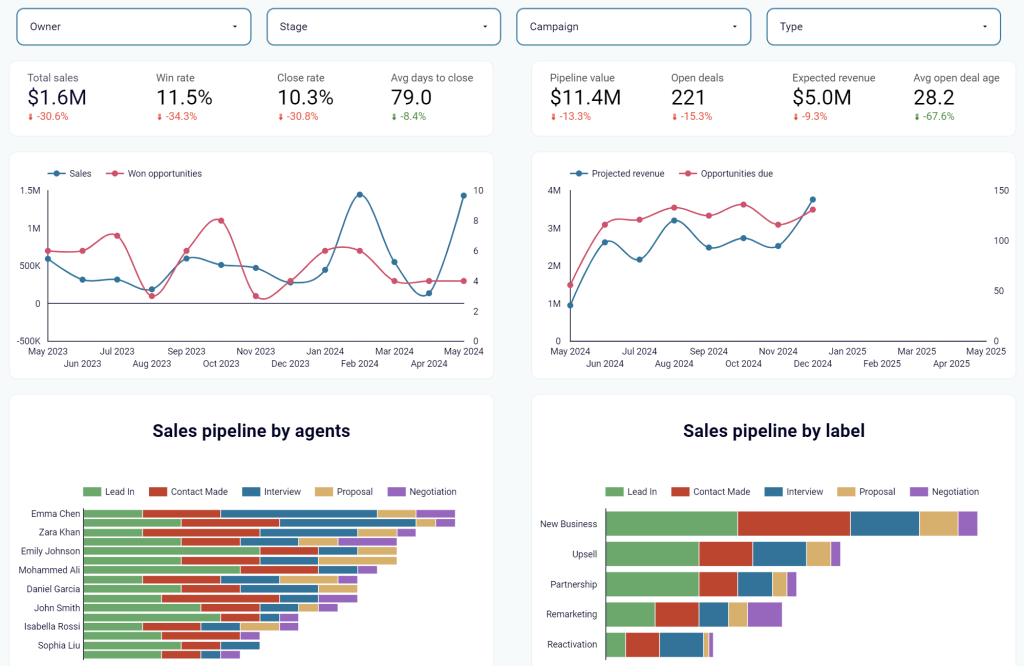
Filter the dashboard data by each sales agent (owner) to get a complete view of the deals closed, the number of deals in progress, the different types of deals they are working on, and the total closed amount. This will help you understand the strengths and weaknesses of each agent and help them to improve accordingly.
Coupler.io provides a CRM dashboard template for different platforms including Salesforce, HubSpot, and Pipedrive. Try the one that meets your analytics requirements.
Employee performance rating dashboard
Employee performance rating dashboards are used during the annual or bi-annual review, where a lot of data is collected from peers, subordinates, managers, and the employee.
The employee performance rating dashboard is a Microsoft Excel template where you can replace the existing scorecard data with your own data to reflect the changes in the dashboard. You can use the same template for collecting data and creating the dashboard.
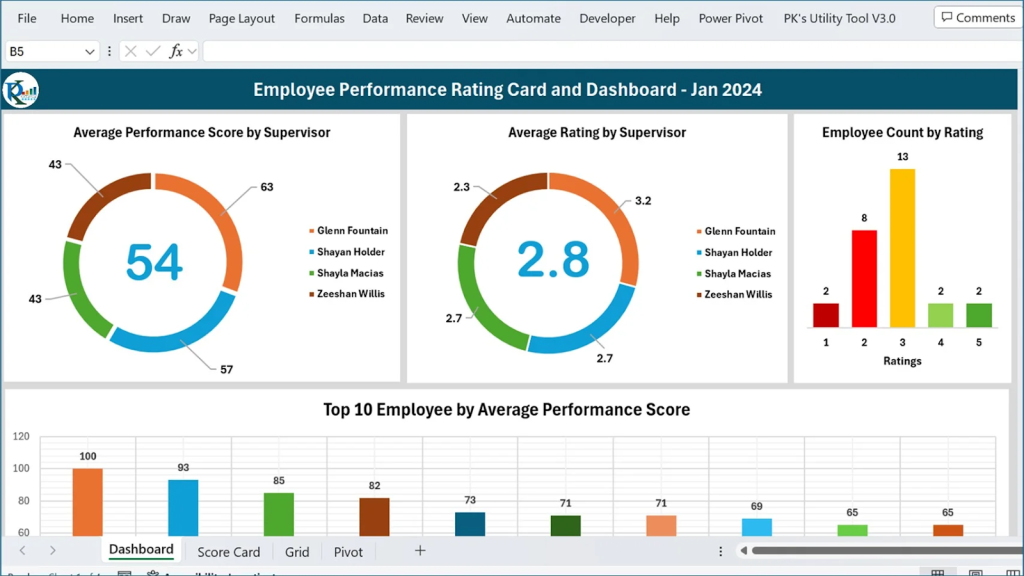
The first two doughnut charts display the average performance scores and ratings from each supervisor, with the overall average for all employees at the center. You can identify the top employees based on average performance scores and reward them accordingly.
Project management KPI dashboard
If you use project-based evaluations to monitor employee performance, this project management KPI dashboard example will be helpful. You can export data from any project management tool (JIRA, Asana, Trello, etc.) to Excel or Google Sheets and build a similar dashboard.
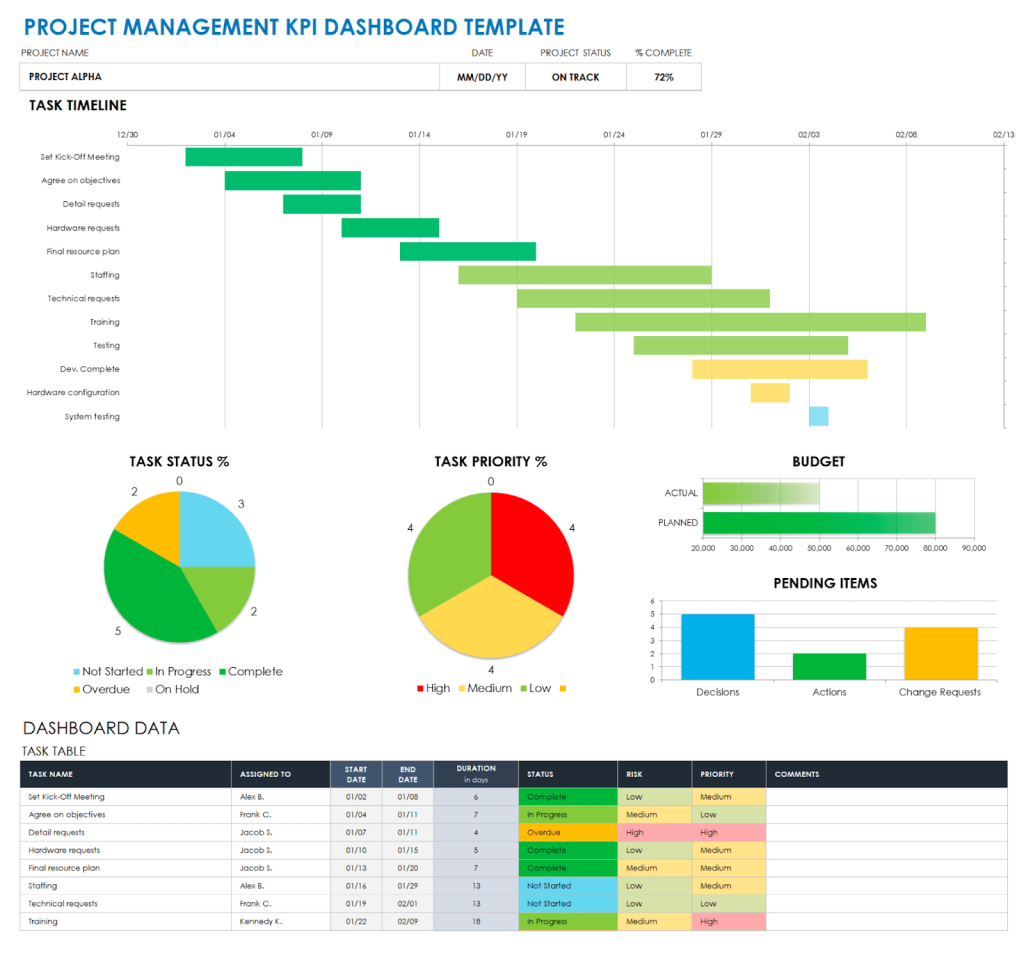
It helps you quickly assess project health and employee performance. You can see who’s on schedule and who’s lagging with the task timeline, and identify bottlenecks using the task status and priority pie charts.
From the task table, you can review workload distribution and manage finances through budget tracking. It’s a tool to manage project efficiency, pinpoint where employees excel, and address areas needing improvement.
Best practices to evaluate employee performance
Nearly every company measures employee performance, but only some manage to do it well and build a skilled team. Along with using different methods, best practices also play a major role in successfully tracking employee performance. By following the best practices discussed below, you do not have to reinvent the wheel and have a smooth journey.
Setup frequent reviews
Employees are 5x more likely to consider feedback as ‘meaningful’ when it’s delivered weekly.
You can start by scheduling weekly 1 to 1 meetings with your team members to talk about challenges, progress, and goals. If weekly feels too often, try bi-weekly reviews. Let the employee speak freely by asking open-ended questions. Then, share your goals for them and make sure they’re comfortable with them.
These meetings are mostly for giving and getting feedback to help both you and your employees grow. Keep notes from each meeting, so you both remember what was discussed. Use these notes for the big yearly review, too, so you don’t forget the small but important stuff they’ve done all year. This makes feedback more useful and helps everyone know what’s expected.
Establish a feedback culture
Use tools like Slack for public thanks and conduct workshops to teach effective feedback methods. Encourage giving feedback every day, create easy-to-use guidelines, and celebrate those who actively engage. Frequent, constructive feedback keeps employees informed about what they’re doing well and where they can improve. A culture that values feedback encourages open communication, promotes professional development, and builds trust within the team.
Give constructive feedback
Constructive feedback is crucial in nurturing employee growth and highlighting specific improvements while giving clear guidance on improving skills or performance. It is in contrast to criticism, which focuses on finding faults without providing an improvement plan.
Constructive feedback is supportive, focusing on how to build on strengths and address weaknesses. For example, rather than saying, “Your presentation was unclear,” you could say, “If you structure your presentation points more sequentially, it will be clearer. Let’s review the slides on organization strategies together.” This method points out areas for improvement and engages in a collaborative effort towards betterment.
Add self-monitoring to your review process
You can incorporate self-monitoring into your review process by having employees assess their own performance on a regular basis. This helps in boosting self-awareness and encourages them to improve actively. Provide tools and clear guidelines for self-assessment, encourage goal setting, and conduct discussion sessions on these self-evaluations.
For example, an employee could keep a weekly log of achievements and challenges, and then use this for monthly progress discussions with their manager. Also, you can provide a comprehensive self-assessment template to ensure employees evaluate all relevant aspects of their performance. This way, the employee will have clarity about what to talk about in the monthly review meeting.
Do not rely on just time to assess performance
Time tracking alone doesn’t fully measure performance. Combine it with both quantitative metrics, like sales and project completion, and qualitative metrics, like teamwork and leadership, for a full view. Introduce time-tracking tools like Clockify and Harvest to the team, and balance them with other goals and personal growth metrics.
Keep your focus on outcomes, celebrate milestones, and provide regular feedback to ensure time tracking supports your broader performance insights without overwhelming employees.
Provide training on unconscious bias
Bias can unconsciously impact performance reviews. Training helps evaluators recognize and minimize biases like confirmation bias, gender bias, and recency bias. By understanding these common prejudices, we can improve performance management’s fairness and effectiveness. Adding practices such as awareness workshops, scenario-based learning, and inclusive evaluation techniques helps minimize bias. You can adapt 360-degree feedback and blind reviews in performance reviews to ensure evaluations are based on merit only.
Legal compliance guidelines
Performance evaluations must be fair, transparent, and legally compliant. Ignoring compliance risks can lead to discrimination claims, legal disputes, or biased promotions.
- Follow local labor laws – Ensure evaluations align with national employment laws (e.g., the Equal Employment Opportunity Act, GDPR, or CCPA).
- Use objective evaluation criteria – Standardized goals and KPIs should form the basis of reviews, rather than subjective opinions.
- Document performance data – Keep clear records of evaluations, promotions, and terminations to protect against legal risks.
- Provide employees access to their records – Employees should be able to review and dispute performance evaluations if needed.
Privacy considerations
Performance tracking involves handling sensitive employee data, so companies must ensure privacy protection and ethical use of data.
- Be transparent – Employees should be informed about what performance data is being tracked and how it is used.
- Get consent – If using AI-based tracking or employee monitoring software, ensure employees agree to data collection.
- Limit access to performance data – Only HR personnel and managers should have access to sensitive employee evaluations.
- Ensure secure data storage – Use encryption and restricted access controls to protect employee performance records.
- Follow GDPR & CCPA compliance – In regions with strict privacy laws, performance data must be collected and stored lawfully.
Change management strategies
Introducing new performance evaluation methods can meet resistance from employees or managers. To ensure smooth adoption, companies should:
- Communicate the ‘why’ clearly – Explain why changes are being made and how they benefit employees.
- Start with a pilot program – Test new evaluation methods with a small team before rolling them out company-wide.
- Provide training sessions – Educate employees and managers on how to use new performance-tracking tools effectively.
- Collect feedback and iterate – Regularly gather employee input to refine performance tracking methods over time.
How to setup employee performance tracking: 90-day implementation plan
A successful performance tracking system needs a structured rollout to ensure smooth adoption, reliable data, and minimal resistance. This 90-day plan breaks down the process into four key phases – planning, piloting, training & communication, and full rollout to help companies set up a system that works.
Phase 1: Planning (Weeks 1-4)
Before rolling out a performance tracking system, you need a clear picture of where you stand and what you need. Which teams will use it first? What data will be tracked? What tools fit your needs? Answering these questions early prevents confusion and ensures a structured, goal-driven rollout.
Map out key stakeholders
Performance tracking impacts multiple teams—HR, managers, employees, and leadership. Each has different priorities and concerns.
- Who will manage the system? (HR, team leads, or a dedicated performance management team)
- Who needs training? (Managers and employees using the system)
- Who will evaluate the results? (Executives or department heads reviewing the data)
Getting stakeholder buy-in early prevents pushback later and ensures everyone understands the benefits of tracking performance.
Assess your current tracking methods
Before introducing new tools, analyze how performance is currently measured and where improvements are needed.
- Are performance reviews consistent across teams?
- Do managers struggle with tracking progress or providing feedback?
- Are employees clear on what is expected of them?
- What data is already available, and what’s missing?
This assessment helps avoid duplication of efforts and ensures the new system fills existing gaps rather than creating unnecessary complexity.
Choose the right tools
Selecting the wrong tools leads to frustration and low adoption. Instead of picking the most feature-packed tool, focus on:
- Ease of use: Can employees and managers adopt it quickly?
- Integration: Does it work with existing HR, project management, or time-tracking software?
- Customization: Can it be tailored to your company’s performance criteria?
- Scalability: Will it grow with your business needs?
Pilot testing a few tools with a small team before committing company-wide can prevent costly mistakes.
Consider data integration capabilities when selecting performance tracking tools. Solutions like Coupler.io can bridge gaps between systems by automatically synchronizing data from multiple sources into unified dashboards. This simplifies the evaluation process and reduces manual data entry errors.
Define a budget
A poorly planned budget can cause delays or force compromises later. Consider:
- Software costs: Subscription fees, one-time setup costs, or customization expenses.
- Training expenses: Workshops, onboarding materials, or hiring an external consultant if needed.
- Implementation resources: Internal project managers, IT support, or system administrators.
- Contingency funds: Unforeseen costs like additional integrations or tool upgrades.
A realistic budget ensures a smoother rollout without unexpected financial roadblocks.
By the end of this phase, you should have a clear plan, budget, and the right tools in place to move forward confidently.
Phase 2: Pilot program (Weeks 5-8)
With a clear plan in place, the next step is testing performance tracking on a smaller scale before rolling it out company-wide. A pilot program helps identify potential challenges, refine tracking methods, and gather employee feedback early, ensuring a smoother full implementation.
Select a pilot group
Start with a small, controlled group—this could be one department, a specific team, or a mix of roles to test how the system works in different scenarios.
Choose:
- A team with manageable complexity (not too small, not too large).
- Employees open to adapting new tools and processes for smoother feedback collection.
- A department whose performance metrics are easier to measure (e.g., sales, customer support, or engineering).
Set clear test metrics
A pilot program is only useful if you know what you’re measuring. Define key performance indicators (KPIs) such as:
- Completion rates for tasks and projects.
- Time spent on key activities (if relevant).
- Employee engagement levels with the system.
- Effectiveness of feedback loops (How quickly and usefully feedback is given and received).
Establish baseline measurements
Before testing, collect preliminary data on current performance levels. This helps in comparing results once the pilot is complete. If the system doesn’t show improvements in clarity, efficiency, or feedback effectiveness, adjustments can be made before scaling up.
Collect feedback regularly
Since this is a test phase, gather insights from managers and employees frequently to understand:
- Ease of use (Are employees comfortable with the system?)
- Relevance of tracked metrics (Does the data provide useful insights?)
- Gaps or inefficiencies (Are there missing features or unnecessary complexities?)
Using surveys, feedback forms, or direct discussions, ensure that the system is fine-tuned before full implementation.
Define success criteria & address risks
Clearly outline what success looks like before moving forward:
- Are managers able to track performance efficiently?
- Do employees feel the system is fair and helpful?
- Is the data accurate, relevant, and actionable?
At the same time, prepare for potential resistance or technical issues. Having a risk mitigation plan in place (such as additional training or system tweaks) will ensure a smoother transition to company-wide rollout.
By the end of this phase, the performance tracking system has been tested on a small scale, success criteria are defined, and risks identified and addressed.
Phase 3: Training & communication (Weeks 9-12)
With the pilot program improved based on feedback, the next step is training employees and ensuring clear communication to drive adoption. Even the best performance tracking system will fail if employees and managers don’t understand how to use it or see its value. This phase focuses on educating users, addressing concerns, and setting expectations for a smooth transition.
Develop a training curriculum
Training should be practical, straightforward, and tailored to different users. Instead of a generic one-size-fits-all approach, break training down into focused modules:
- Tool usage guides – Step-by-step instructions on how to use the tracking system.
- Performance metrics explanations – Clear definitions of what is being tracked and why.
- Review process documentation – Guidelines on how evaluations will be conducted and how feedback will be used.
Best practice: Offer live sessions, recorded tutorials, and quick reference guides so employees can learn at their own pace.
Address employee concerns proactively
Change often leads to questions and resistance. Employees might worry about:
- How their performance will be evaluated.
- If the system is fair and transparent.
- Whether tracking will lead to micromanagement.
Best practice: Be upfront about the purpose of performance tracking to prevent pushback.
Use clear & engaging communication
To keep employees informed and engaged, use simple, transparent messaging through multiple channels:
- Announcement emails – Introduce the system, explain its benefits, and set expectations.
- FAQ document – Address common concerns and provide quick answers.
- Progress updates – Keep employees informed about key milestones in the rollout.
- Feedback forms – Encourage employees to share concerns and suggestions.
Best practice: Highlight success stories from the pilot phase to show real-world benefits of the system.
By now, employees and managers fully understand how to use the system and what’s expected of them. Concerns and resistance are addressed with clear communication. Performance tracking is becoming a part of company culture.
Phase 4: Full rollout (Weeks 13-16)
With training complete and employees familiar with the system, it’s time to implement performance tracking across the entire organization. This phase ensures easy integration, minimal disruptions, and ongoing support for a successful transition.
Implement department-wise rollout
Instead of switching on the system for everyone at once, roll it out in stages. Start with high-priority teams (e.g., sales, customer service, or engineering) before expanding to the rest of the company. This controlled deployment helps identify any last-minute issues before full-scale adoption.
Migrate & integrate data
Ensure a smooth transition by migrating any existing performance data into the new system and integrating it with:
- HR platforms for seamless employee records.
- Project management tools to track productivity.
- Time-tracking software to align with work hours (if applicable).
A system integration checklist ensures all tools work without data inconsistencies or technical failures.
Conduct final quality & compliance checks
Before full adoption, verify system performance and legal compliance by ensuring:
- Data accuracy – No discrepancies in tracking metrics.
- Privacy compliance – Aligns with GDPR, CCPA, and labor laws.
- System stability – No technical bugs or crashes.
Conduct a final review with key stakeholders to confirm that the tracking system meets company goals before fully launching.
Provide ongoing support
Even after launch, employees will need guidance and troubleshooting. Set up:
- A dedicated support team to handle concerns.
- Clear documentation (quick guides, FAQs, troubleshooting manuals).
- Regular check-ins to ensure employees are using the system effectively.
By the end of this phase, the performance tracking system should be fully implemented across the organization and all departments using it with minimal disruptions.
Success metrics
A performance tracking system is only effective if you can measure its impact. These success metrics help determine whether it’s working for your team, identify any gaps, and make necessary improvements.
| Metric | What it measures | Why it matters | How to calculate |
|---|---|---|---|
| Adoption rate targets | Percentage of employees actively using the system | Ensures company-wide engagement and usability | (Number of employees using the system ÷ Total employees expected to use it) × 100 |
| Data accuracy metrics | Percentage of performance records that are correct and free from errors | Makes sure performance evaluations are based on reliable, unbiased data | (Number of accurate records ÷ Total records) × 100 |
| Employee satisfaction scores | Employee feedback on the performance tracking system | Helps gauge employee acceptance and engagement, identifying areas for improvement | (Sum of employee survey scores ÷ Total possible survey scores) × 100 |
| Manager feedback ratings | How useful managers find the system in tracking and evaluating employee performance | Ensures the system provides meaningful insights that support performance evaluations and decision-making | (Sum of manager rating scores ÷ Total possible rating scores) × 100 |
| System uptime goals | Percentage of time the performance tracking system is operational | Minimal disruptions in performance monitoring and reliable access to data | (System uptime hours ÷ Total hours in a period) × 100 |
| Compliance adherence rates | Percentage of compliance policies followed in performance tracking | Ensures performance tracking aligns with labor laws, data privacy policies, and company regulations | (Number of compliance-verified actions ÷ Total required compliance actions) × 100 |
Risk management
Even with careful planning, issues like system failures, inaccurate data, or privacy concerns can arise. A proactive risk management plan ensures these challenges are handled before they disrupt performance tracking.
To minimize risks, organizations should focus on technical reliability, data privacy, employee acceptance, contingency planning, and a clear escalation processes. Let’s look at each of these in detail below.
Technical risks assessment
The data must be accurate to track employee performance effectively. If a tool fails, it provides inconsistent results, or doesn’t work well with existing systems, and eventually tracking becomes unreliable.
To prevent this, follow these steps:
- Conduct regular system audits: Schedule monthly data accuracy checks to ensure tracking tools record performance correctly.
- Set up automated alerts: Use alerts to flag missing or inconsistent data so managers can address issues early.
- Test integrations before rollout: Ensure the system seamlessly syncs with payroll, HR, and project management tools before full implementation.
- Plan for system downtime: Have backup tracking methods (manual logs, offline tools) ready in case of software failures.
Resistance management plan
Many employees may feel that performance tracking is invasive, unfair, or too focused on numbers rather than effort. Resistance can lead to low adoption rates, inaccurate self-reporting, and negative workplace morale.
To encourage acceptance, consider these strategies:
- Communicate the purpose clearly: Emphasize that tracking helps identify growth opportunities, not just measure output.
- Involve employees in goal setting: When employees help define performance metrics, they are more likely to engage.
- Balance quantitative and qualitative data: Combine task completion rates with manager feedback to get a full picture of performance.
- Provide a feedback loop: Create a system where employees can challenge inaccurate data or tracking results.
Data privacy checklist
Performance tracking involves collecting work patterns, productivity metrics, and sometimes behavioral data. Without proper safeguards, companies risk legal violations and loss of employee trust.
To ensure compliance and protect employee privacy, follow these best practices:
- Only collect relevant data: Limit tracking to necessary performance indicators (e.g., task completion, productivity trends).
- Set role-based access controls: Restrict who can view employee performance data based on job function.
- Regularly review compliance policies: Conduct quarterly legal audits to ensure tracking methods align with privacy laws.
- Allow employees to request data corrections: Provide a process for employees to challenge or correct errors in their performance records.
Contingency procedures
Even with a well-planned system, unexpected failures can happen. Companies need a backup plan to keep tracking uninterrupted.
- Automate regular data backups: Ensure performance records are backed up daily or weekly to prevent data loss.
- Maintain an alternative tracking method: Have manual logs or offline spreadsheets ready for tracking in case of system failure.
- Create an emergency action plan: Define clear steps for IT, HR, and managers to follow if tracking is disrupted.
Escalation matrix
If employees experience issues with performance tracking, there should be a clear resolution process. Without a structured escalation plan, unresolved concerns may create frustration or compliance risks.
- Define clear resolution steps: Employees should know who to contact for different tracking issues.
- Establish tiered escalation levels: Ensure issues are handled at the right level:
- Tier 1: Employee concerns ? handled by HR or direct managers.
- Tier 2: Technical problems ? handled by IT support.
- Tier 3: Compliance concerns ? reviewed by legal and compliance teams.
- Set response time targets – Establish a timeline (e.g., IT issues resolved within 48 hours, compliance concerns within a week) to maintain trust.
Support documentation for smooth adoption and troubleshooting
Even the best performance tracking system needs clear documentation to help employees and managers use it effectively. Without proper support materials, users may struggle with system navigation, misinterpret data, or face technical issues without knowing how to resolve them. The following documents ensure smooth adoption, efficient troubleshooting, and ongoing system improvements.
Troubleshooting guides
Common issues like login errors, incorrect data displays, or integration failures can slow down productivity. A troubleshooting guide should provide:
- Step-by-step solutions for frequent technical issues.
- Error codes and resolutions to help users fix problems quickly.
- Contact details for IT support when further assistance is needed.
Example: If an employee sees incorrect performance data, the guide should include steps to refresh reports, verify data sources, and escalate concerns if needed.
Best practices manual
A guide for managers and employees on how to use the tracking system effectively. This includes:
- How to interpret performance data (e.g., understanding trends vs. one-time fluctuations).
- Best ways to give and receive feedback based on tracking insights.
- Dos and don’ts of performance tracking to avoid misusing data.
Example: Instead of using time-tracking reports to micromanage employees, managers should focus on long-term productivity trends and goal alignment.
Quick reference cards
Short, one-page summaries that provide essential system instructions at a glance. These include:
- How to log in and navigate dashboards.
- How to update performance data or track goals.
- Shortcut keys or commands for quick access to features.
Example: A reference card could list ‘3 steps to submit a self-assessment’ so employees can complete it without searching through long documents.
Process flow diagrams
Process flow diagrams are visual guides showing how performance tracking works from data collection to evaluation. These diagrams clarify:
- What data is tracked and how it flows through the system.
- Who reviews and approves performance reports.
- What happens after a performance review (e.g., feedback, training recommendations).
Example: A diagram could map how project completion rates are tracked from task assignment to final reporting.
Contact information
A centralized support directory ensures employees know where to get help. Include:
- HR and IT support contacts for technical or policy-related questions.
- System administrators responsible for troubleshooting and updates.
- Compliance officers for concerns about data privacy or legal issues.
Example: A helpdesk email and response time expectations ensure that issues are resolved efficiently.
Maintenance plan: keeping performance tracking effective long-term
A performance tracking system should not be a set-it-and-forget-it tool. Regular maintenance ensures accurate data, smooth functionality, and continuous improvements. Without a structured plan, systems can become outdated, unreliable, or difficult to use over time.
Follow the steps below to maintain the performance tracking system.
Regular review schedule
Set up quarterly or bi-annual reviews to assess:
- System performance – Are there slowdowns, bugs, or inefficiencies?
- Tracking effectiveness – Are the right metrics being monitored?
- User adoption – Are employees and managers actively using the system?
Example: If employees find tracking confusing or ineffective, adjust training or update reporting formats to improve usability.
Update procedures
Performance tracking tools and business goals evolve, so the system must stay aligned. Plan for:
- Software updates – Ensure the latest version of tracking tools is used.
- Metric adjustments – Add, remove, or refine tracked KPIs as business needs change.
- Policy updates – Modify tracking guidelines to reflect new company strategies.
Example: A company shifting to a hybrid work model may need to track new productivity metrics that balance remote and in-office performance.
Backup protocols
Data loss can disrupt performance evaluations and create compliance risks. Prevent this with:
- Automated data backups – Daily or weekly backups to secure records.
- Multiple storage locations – Cloud-based and offline storage options.
- Disaster recovery plans – Defined steps for restoring lost or corrupted data.
Example: If a cyberattack wipes out performance records, a backup ensures no critical data is permanently lost.
Performance optimization checklist
Keep the system running efficiently by:
- Monitoring user feedback – Are employees experiencing issues or delays?
- Fixing inefficiencies – Remove redundant steps in performance tracking.
- Improving report accuracy – Ensure tracking tools pull the right data.
Example: If managers find reports too complex, simplify dashboards to highlight key insights instead of unnecessary details.
Continuous improvement framework
To keep performance tracking relevant, establish a feedback-driven improvement cycle.
- Regular employee and manager surveys – Gather insights on system usability.
- Benchmarking against industry trends – Stay updated on best practices.
- Annual strategy review – Align tracking methods with company growth plans.
Example: If an organization moves toward AI-driven analytics, integrate smarter performance insights into tracking systems.
By following this phased approach (planning, piloting, training, and full rollout), companies can minimize disruptions, gain employee buy-in, and ensure that tracking aligns with company goals.
Benefits of employee performance tracking
Organizations that have highly engaged teams show 21% greater profitability. Tracking your employee performance and helping them grow in their roles with constructive feedback is the first step to building engaged teams.
Along with profitability, below are the benefits of tracking employee performance.
- You can use concrete data to evaluate performance, ensuring fair and unbiased reviews.
- While tracking employee performance, you identify specific skill gaps in certain employees. You can conduct targeted training programs to improve their capabilities.
- Through regular feedback and recognition, employees show increased motivation and job satisfaction.
- It highlights top performers and rewards them accordingly to boost employee engagement.
- By pinpointing areas for improvement, it leads to strategies that boost individual and team productivity.
- It aligns individual performance with organizational goals, making sure everyone is working towards the same objectives.
Employee performance monitor: timing recommendations and future trends
Monitoring employee performance works best when done at key moments like:
- Regular check-ins are times to touch base on work challenges, progress, blockers, and new ideas, scheduled weekly or monthly at your convenience.
- After reaching project milestones, set meetings to review what’s been achieved.
- Conduct traditional performance reviews annually or bi-annually during formal review periods.
- Following training programs, evaluate their effectiveness and how they enhance skills.
- During role transitions, discuss new responsibilities and expectations.
- Lastly, when organizational goals shift, reassess and realign employee objectives to match the new direction.
These structured touchpoints ensure employees receive timely feedback and support without feeling overwhelmed.
However, workplaces are shifting from rigid, scheduled evaluations to a more flexible and real-time approach. As they evolve, companies are using AI-driven insights, continuous feedback, and automation to make performance tracking more data-driven, unbiased, and responsive.


